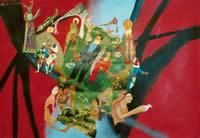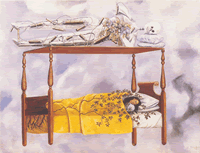“Death Dances Around My Bed”
 Frida Kahlo’s words about her death dance became a vivid portrait of how our unwanted agonies can be our greatest teachers. This Mexican artist’s paintings illuminate her life story and illustrate that Frida’s artistic images were her psyche’s voice. For Frida, life and death existed simultaneously from her birth till her death. This paradox compelled her to create images of her bloody and golden body. Frida boldly painted her reality with its pain, losses, and betrayals. The shadow usually hidden is revealed, and then a metamorphosis took place on her canvas.
Frida Kahlo’s words about her death dance became a vivid portrait of how our unwanted agonies can be our greatest teachers. This Mexican artist’s paintings illuminate her life story and illustrate that Frida’s artistic images were her psyche’s voice. For Frida, life and death existed simultaneously from her birth till her death. This paradox compelled her to create images of her bloody and golden body. Frida boldly painted her reality with its pain, losses, and betrayals. The shadow usually hidden is revealed, and then a metamorphosis took place on her canvas.
Frida imagined herself wearing a Mexican death mask, a symbol of being born of a dead (depressed) mother. Her father’s love and adoration caused a series of injuries to her sexuality and created complex family dynamics, holding both the pain and joy of being the father’s daughter.
Without personal relationships to help her metabolize her family complexes, Frida turned to her imagination, and her child’s archetypal energies and began to paint from an early age. This death mask became a symbol of all her family complexes.
Through a deep appreciation of her Mexican and Aztec motherculture, Frida felt connected to Coatlique, the Aztec goddess of death, destruction, dismemberment and life. She suffered from polio at the age of six. At the age of 18, a bus accident changed the course of her life.
Frida was gravely injured. Pain and suffering ruled her life. Frida was confined to her bed for a year and had numerous surgeries, suffered from infertility and turned from her medical career to art. Coatlique guided Frida’s brush to paint the tortured body she experienced daily.
The loneliness of her confinement allowed her to develop an empathic mirroring through her self-portraits and led to her deepening relationship to Diego Rivera, her husband. Their relationship was tumultuous, laced with infidelities and betrayals, allowing her to enact her family dynamics and complexes. Paradoxically, Diego was her artistic, cultural and political mentor. He intensified her bond with her motherculture, which opened her to more archetypal images in her art. Her paintings helped her metabolize these horrific experiences, quietly first as Diego’s wife and boldly later as an icon of the wounded and triumphant feminine.
Frida’s latter paintings and self-portraits changed dramatically as life started to leave her body. Her art now held the ego and archetype and manifestations of the self and Self.
This presentation will delve into the intimate relationship between Kahlo’s art and the Archetypal Death. Using a Jungian expressive arts therapy lens, I will discuss her psyche’s relationship to her art through a power point, DVD and verbal format. Participants will be invited to express their experience through inner-directed somatic, visual and poetic active imagination processes. We will close with a group discussion.
Learning Objectives:
- Exploring the archetype of death and its relationship to a creative personality through an Expressive Arts Jungian Lens.
- Experiencing expressive arts processes that can aid ourselves and our clients in facing death, illness, miscarriages and symbolic death such as failure and rejection.
- Learning about cross-cultural differences in forming a relationship with the archetype of death that can influence our clinical expressive arts private.
Biography of the Presenter:
Kate T. Donohue, Ph.D. REAT is a founding faculty member of CIIS’ EXA program and founding IEATA board Professional Standards Board Member. She coordinates the EXA group supervision program and has conducted numerous supervision workshops and Jungian oriented expressive arts consultation groups. Dance and painting inform all her expressive arts therapy and supervision.
(image © Frida Kahlo Museum)








